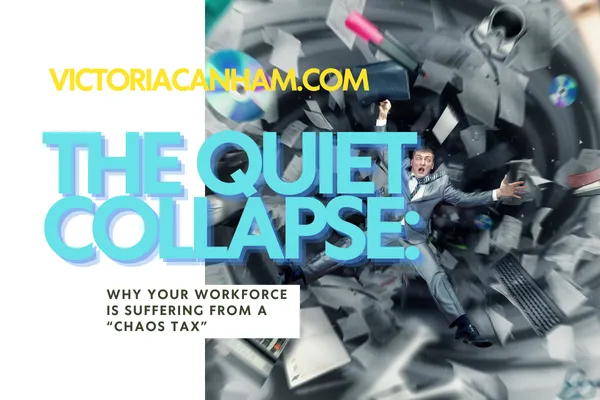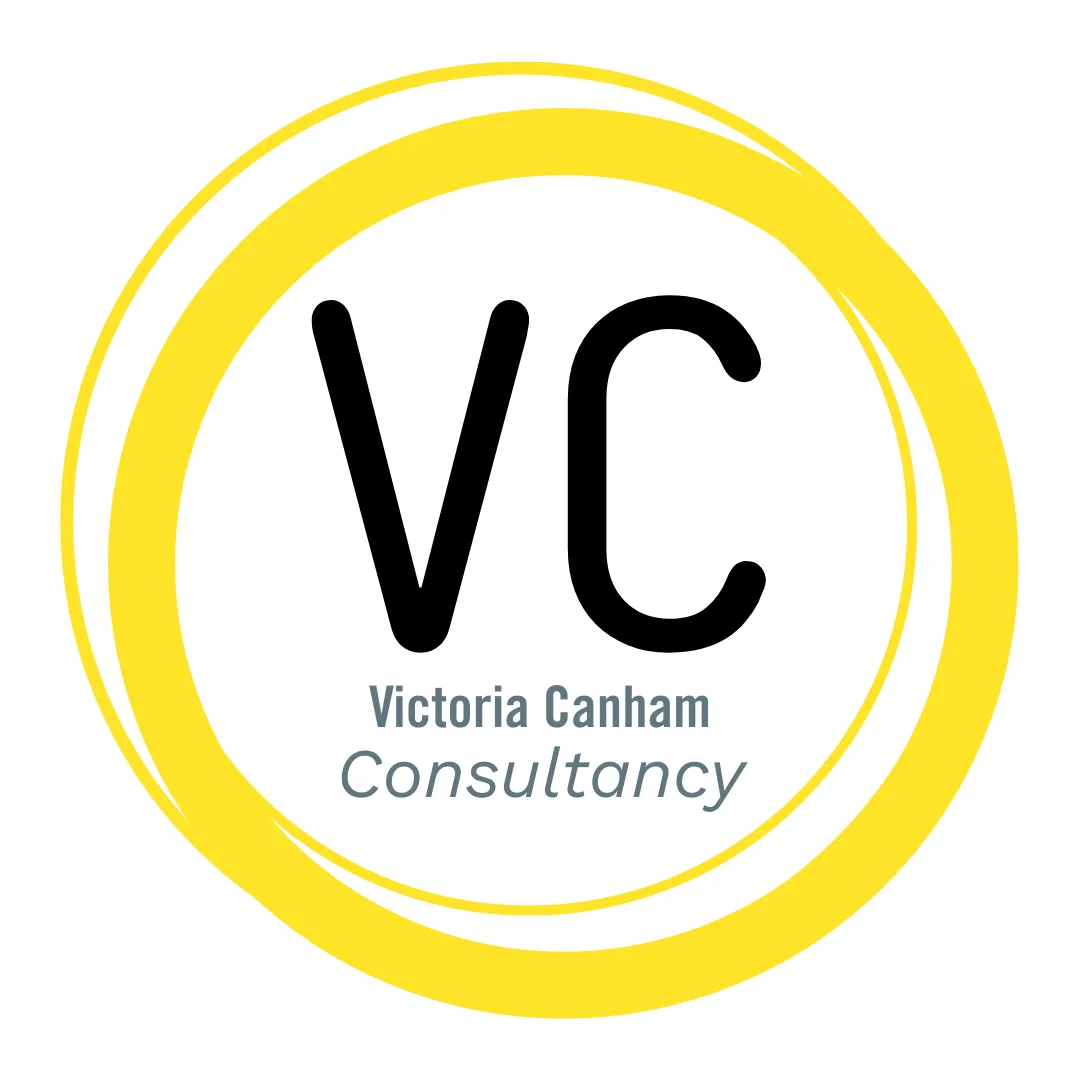The Quiet Collapse: Why Your Workforce Is Suffering from a “Chaos Tax"
Victoria Canham • 20 August 2025 • 5 min read

“What can leaders do today to potentially save the world?
Gallup has found one clear answer: Change the way your people are managed.”
JON CLIFTON | CEO, GALLUP
For the first time in four years, Gallup’s global engagement report has sounded a serious alarm for leaders: worldwide employee engagement has dipped to a worrying 21%. But the real headline is something subtler and far more concerning: manager engagement has also dropped. This isn’t a surface-level HR problem; it’s a warning signal for the very health of our organisations.
As someone who has advised dozens of global leadership teams on employee experience, I’ve seen firsthand how a phenomenon I call the “chaos tax” silently erodes performance, morale, and innovation.
What Is the Chaos Tax?
We are firmly in the “Experience Era,” where organisations compete not only on products and services but also on the quality of the employee experience. The principle is simple: engaged, supported employees perform better, innovate more, and drive growth. Yet, in many organisations, well-intentioned interventions have backfired.
Every new app, every new workflow, every pivot in hybrid or flexible work models, without careful management, adds layers of complexity. This constant friction drains employees’ energy, creates mental clutter, and leads to disengagement. The result is a silent tax on productivity and wellbeing.
Consider the modern corporate environment: employees juggling multiple platforms for communication, reporting, collaboration, and performance tracking. They attend meetings to clarify instructions that were buried in emails, navigate redundant approvals, or spend hours reconciling data across systems. While each initiative was intended to make work smoother, collectively they create confusion, stress, and burnout. This is the chaos tax in action.
The Human and Business Cost
This isn’t just a “people issue”; it’s a strategic, financial imperative. Gallup estimates that low engagement costs the global economy a staggering $8.8 trillion. In the UK, a recent survey found that the average employee wastes over three weeks a year on inefficient processes and unnecessary administration.
And it’s not only about time lost. The chaos tax eats into innovation, collaboration, and trust, the very foundations of high-performing organisations. When employees are constantly navigating friction, they retreat into task management mode rather than strategic thinking. Creativity falters. Decision-making slows. High-potential talent quietly leaves for workplaces that offer clarity, autonomy, and psychological safety.
Why Managers Are at Risk Too
The Gallup data shows manager engagement is falling alongside their teams. This is especially critical because managers act as the interface between strategy and execution. When managers are overburdened by operational chaos, they have less bandwidth to coach, mentor, lead, and inspire their teams.
In practice, this often looks like:
❇️ Managers spending hours on reporting and administrative tasks rather than strategic leadership.
❇️ Teams receiving mixed messages because managers themselves are unclear on priorities.
❇️ High turnover among mid-level leaders creating a vacuum that compounds the chaos.
This is not the fault of the people; it is a systemic design problem. Organisations often misinterpret symptoms as engagement issues, rather than examining the structural complexity causing disengagement.
Lessons from Organisations That Get It Right
Some organisations have successfully fought back against the “chaos tax”. These companies recognise that tools and processes should serve people, not the other way around. Key practices include:
1. Intentional Technology Use
Leading organisations evaluate every new platform or process through the lens of cognitive load: Does this reduce friction, or add another layer? For example, a multinational client I worked with consolidated five separate project management tools into one unified platform. Within six months, cross-team collaboration increased, and productivity metrics rose by 18%.
2. Process Simplification
Organisations that thrive intentionally streamline approvals, eliminate redundant tasks, and clarify decision-making authority. It may seem like a small operational tweak, but these simplifications signal respect for employees’ time and intelligence.
3. Culture of Psychological Safety
Teams perform best when they can speak up, make decisions, and take risks without fear. Companies that prioritise transparency, clear communication, and trust see far lower turnover and higher engagement scores. The chaos tax is neutralised when employees know what matters most and feel empowered to act accordingly.
4. Measurement Beyond Metrics
Engagement surveys alone are not enough. Top organisations triangulate data with observational insights, focus groups, and qualitative feedback to understand where friction occurs. This allows leaders to anticipate issues rather than react to disengagement.
Leadership Implications
If you are a senior leader or HR director, the chaos tax should be top of mind, not just as a people challenge, but as a strategic priority. It raises several questions:
✳️ Are our systems and processes optimised for clarity, or have they become unnecessarily complex?
✳️ Are we designing experiences that enable employees to thrive, or inadvertently draining their energy?
✳️ Do managers have the bandwidth to lead effectively, or are they trapped in administrative mazes?
Answering these questions requires courage and intent. It is easier to add another app, tool, or initiative than it is to critically examine existing systems, but the latter is far more valuable.
The Intersection of Strategy and Psychology
The chaos tax reminds us that employee experience is not just operational; it is deeply psychological. Organisations that recognise this intersection win. They understand that human brains are wired for simplicity, predictability, and trust. When these needs are unmet, no amount of perks, gamification, or team events can fully engage employees.
In practice, this means designing every experience (recruitment runway planning, recruitment, hiring, onboarding, performance reviews, project launches, daily workflows, employee development, and employee interactions and exits) with the employee’s perspective in mind. Clarity, predictability, and a sense of control are non-negotiable.
What Leaders Can Do Today
Here are concrete steps leaders can take to reduce the chaos tax:
1. Map Employee Journeys – Identify friction points across the employee lifecycle. Focus on processes that cause repeated stress or confusion.
2. Audit Technology and Tools – Consolidate, integrate, and retire systems that create cognitive overload.
3. Simplify Decision-Making – Clarify roles, responsibilities, and escalation paths to reduce back-and-forth and uncertainty.
4. Coach Managers – Equip leaders to provide clarity, empower teams, and model calm under pressure.
5. Measure and Iterate – Use qualitative insights alongside engagement metrics to continuously refine the experience.
Take Action Now
The future of work belongs to leaders brave enough to make the complex simple. The organisations that thrive will be those that fight the chaos tax not with more tools, but with more intentionality. They prioritise people, streamline processes, and design experiences that respect energy, time, and mental bandwidth.
The cost of inaction is high: disengaged teams, stifled innovation, and a workforce that quietly exits the organisation. But the opportunity is higher: by reducing friction, you unlock focus, creativity, and resilience—the true engines of growth.
As a performance and culture consultant, I’ve helped leaders redesign employee experiences to reclaim productivity and engagement. The question is not whether the “chaos tax” exists—it’s whether you are taking deliberate steps to counter it before it silently erodes your organisation from within.
If you are ready to measure the chaos tax in your own organisation and design a human-centred experience that drives both engagement and results, start today. The difference between a disengaged workforce and a high-performing team often lies in the courage to simplify, clarify, and put the human at the heart of every strategy.
As an expert on Employee Experience, I can help you. Let’s chat.
🔻
I am Victoria Canham. Performance Coach. People Partner. Straight-talker.
I work with ambitious leaders and businesses who want more than just high performance—they want a workplace culture where clarity, courage, and humanity lead.
After two decades in talent, culture, and leadership development (and one previous life as a chef!), I’ve coached hundreds of professionals to ditch performance plateaus and lead with purpose.
If you're ready to build a team that actually delivers—without burning out your people—let’s talk.
👉 Book a Clarity & Culture Call
Follow me on LinkedIn for more insights on building high-performing teams in 2025.
Comment On This Article
Recommended Reading
Fast Asleep: How to get a really good night's rest by Dr Michael Mosley
A good night's sleep is essential for a healthy brain and body. So why do so many of us struggle to sleep well? In Fast Asleep, Dr Michael Mosley explains what happens when we sleep, what triggers common sleep problems and why standard advice rarely works.
Prone to insomnia, he has taken part in numerous sleep experiments and tested every remedy going. The result is a radical, four-week programme, based on the latest science, designed to help you re-establish a healthy sleep pattern in record time.
With plenty of surprising recommendations - including tips for teenagers, people working night shifts and those prone to jet lag - plus recipes which will boost your deep sleep by improving your gut microbiome, Fast Asleep provides the tools you need to sleep better, reduce stress and feel happier.
We’re not just about overcoming obstacles, we’re about transforming lives.
Book Recommendation

Victoria Canham - Performance and People Strategic Partner
Victoria Canham is an ICF-accredited Certified Professional Coach and the founder of Victoria Canham Consultancy. We are a specialist performance consultancy partnering with senior leaders and HR teams to elevate culture, leadership, and employee experience. Rooted in behavioural insight and change expertise, we diagnose what's truly holding performance back, co-creating practical, strategic interventions that drive sustainable business results and build workplaces that work—for people and performance.
Hang out with us on social media
FREE RESOURCES


💸 Your people don’t leave for money. 💣 They leave for culture. 🔧 I fix that. 🏆 Retention & performance strategy that works.
Book a ☎️ | Fix the Leaks
LET'S WORK TOGETHER
Book a call to find out how I can help you to achieve your peak performance.
© Copyright 2025 Victoria Canham Coaching | Website built by Me on FEA Create (aff.)
Performance Coaching Reading, London, Berkshire, Oxford | St George's Road, Reading, Berkshire, United Kingdom, RG30 2RL | +44 7377 527 529 | [email protected] Open Monday to Friday 9 am until 5 pm

 RSS Feed
RSS Feed